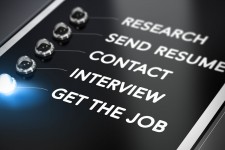Does Your Resume Pass the 10-Second Test?

Passing the 10-Second Test
Last month, while getting ready for a move, I came across my original resume from 1984. It was crafted on a typewriter on beautiful non-erasable paper during my final semester of college. Back in those days, resumes were sent by postal mail as there were no personal computers and of course, no internet.
During the subsequent 30+ years, I had been on over 100 interviews, been a hiring manager at large companies interviewing hundreds more and a global recruiter, placing candidates all around the world. What I can tell you is that the art, process and function of resumes has greatly changed.
Today almost all resumes are sent electronically by email to companies and recruiters, or in response to jobs posted on the major job boards (LinkedIn, Indeed, Glassdoor, Monster, CareerBuilder. I can honestly say that over the past 30 years I have personally reviewed a hundreds of thousands of resumes. What I have found is a recurring theme. Over 95% of them do Not Pass the 10-Second Rule. That means the typical recruiter, HR representative or hiring manager spends less than 10-seconds reviewing your resume to determine if they wish to read more and dig deeper or hit the proverbial delete key. Testimonials
So, how to you make it past the 10-second rule? Resume writing and applying for jobs today is so much different than it was 30 years ago. There are now applicant tracking systems, parsing software and keyword searches. If I am a hiring manager or HR representative, I am looking for key pieces of information in your resume to determine if want to spend more time and look further. Applying for a job today is a process. And each step is a process. If you do not make it pass the first step (10-second rule) and make it to the next step, you are finished before you even really get started. How do you get from your resume, to an interview and to an offer of employment? It all starts with your resume. If what the reviewer is looking for is not easily found at the top of your resume, they will not dig further to look for it. Learn More
Here is How Your Resume Should be Laid Out
- A Professional Summary – If you have 20+ years of experience and multiple positions, you need to pull out at least one important item from each position and place it in your professional summary. This can include; number of years of experience, industries that you worked in, education, measurable achievements, number of direct or indirect reports, etc.
- Today’s style of resume is more accomplishment driven. No longer can you just include a list a bullet points of your responsibilities. The trend is you need to project yourself as an achiever, not just a doer. Use descriptive adjectives and vary them (ex: created, developed, improved, implemented, innovated, simplified, deployed, consolidated, mastered, strengthened, accelerated, motivated) So, the professional summary is a short narrative on the highlights of your career followed by bullet points of several key areas of experience.
Here is an Example of the Narrative of My Professional Summary
Dynamic, seasoned, human resources leader with 20+ years of success in the recruitment and successful onboarding of high quality talent both domestically and internationally. Expert in the analysis of organizational structures,  benefits and insurance, finance, operations and the crafting of new human resource policies to boost employee engagement. Demonstrated background in increasing regulatory compliance within the Human Resources arena, ensuring compliance with relevant employment laws, and the development and maintenance of employee personnel files. Skilled in the resolution of employee grievances, harassment investigations, workers compensation claims and the facilitation of exit interviews.
benefits and insurance, finance, operations and the crafting of new human resource policies to boost employee engagement. Demonstrated background in increasing regulatory compliance within the Human Resources arena, ensuring compliance with relevant employment laws, and the development and maintenance of employee personnel files. Skilled in the resolution of employee grievances, harassment investigations, workers compensation claims and the facilitation of exit interviews.
I am an HR executive, so some of my bullet points would include Global Talent Acquisition, Benefits and Insurance Administration, Payroll, On-boarding, employment contracts, regulatory compliance, performance reviews, HRIS and Applicant Tracking systems. These bullet points serve 2 purposes. The first is visually. A hiring manager for my industry can easily see that I have experience in all these areas. The second is that the applicant tracking systems and parsing software will pick up and identify all key keywords contained within your document.
After your career professional summary, you should start with your most recent position first. Again, the same format (narrative and bullet points of accomplishments). Start with the company name, the position and the dates of employment. Always be sure to include the months not just the years. As a recruiter it was always a pet peeve of mine because if someone had for example 2012 – 2014; Is that 3 years or if you were hired in December of 2012 and left in January of 2014, that’s 1 year and 2 months, not 3 years
Examples of Some of My Accomplishments. Remember – Measurable

- Researched, evaluated, selected and implemented new organization wide employee benefits program reducing deductibles and out of pocket expenses by 50%
- Identified 3,000 candidates, set up and coordinated 150 interviews over a two-day period in two Italian cities, in less than three weeks resulting in the hiring of 40 staff for the client.
- Grew company from a staff of 1 to a staff of 9 resulting in an annual revenue of $1M and 3000 translators in servicing over 100 language combinations.
Next is your education. If you are a recent college graduate, you may not have much work experience, so your education should be first. Otherwise, it should be placed towards the end of the document. If your education is over 15-20 years old, do not include the dates of graduation. Although people may not admit it, there is still age bias for older candidates.
Here is How Your Education Should Look
Master of Business Administration, Concentration in Finance and Entrepreneurship
Nova Southeastern University, Fort Lauderdale, FL
Business Administration - Finance and Economics
State University of New York, College at Brockport, Brockport, NY
Technology/Software Experience. List every technology that you have used. I have dozens that I have achieved expert level knowledge in. This section not only shows the technology and software you know, it also shows your ability to learn new ones.
Awards. I received an award from the United States Department of Defense – The Patriotic Employer Award, so I included it.
Published Articles. If you have any published papers or articles, include it here. I had a magazine article published - Global Trade Magazine: Hire Education: Employee Laws when Expanding into Europe, so I included it here.
Other Important Resume items
- Header/Footer – Include it at the top of each page, but not in the header portion of MS Word. Also, do not include tables, borders or crazy looking bullet points. These create a problem for ATS
- For each position create a narrative section first, but instead of a skills section, it is labeled key contributions/accomplishments.
- Most resumes will be scanned and skimmed and won’t be entirely read if the reviewer can’t immediately find what they are looking for.
- The rule of thumb is that we want to show detail/bullets on positions going back no farther than 15 years – with dates. However, I would include one line for each position greater than 15 years. This was relevant to
 me because I had many positions with name brand recognized companies that I wanted to reviewer to know about. My first job in 1984 was with Goldman Sachs. I definitely wanted people to know I worked there but not include the dates ex: Accountant, Goldman Sachs and Company, (Investment Bank) New York, NY but no dates.
me because I had many positions with name brand recognized companies that I wanted to reviewer to know about. My first job in 1984 was with Goldman Sachs. I definitely wanted people to know I worked there but not include the dates ex: Accountant, Goldman Sachs and Company, (Investment Bank) New York, NY but no dates. - Your email address is actually important. You shouldn’t use names or providers like Hotmail, AOL. Preferably Gmail. The prefix should be recognizable. Yours is currently fine. However, think about possibly creating another Gmail address/account because you will be receiving a great many alerts and you may not want to mix these alerts with your other daily email
So now you have it. If you follow these procedures you will not only make your resume pass the 10-second test, but you will have the reader review your entire resume and hopefully schedule an interview
<button data-leadbox-popup="xbaSvBNMCTdoW9Ld9JVsFU" data-leadbox-domain="globalexpansion.lpages.co" style="background: rgb(0, 30, 138);border-color: rgb(0, 30, 138);border-radius: 20px;color: #FFFFFF;display: inline-block;vertical-align: middle;padding: 16px 32px;min-width: 192px;border: 1px solid rgb(0, 30, 138);font-size: 1rem;font-family: Helvetica, Arial, sans-serif;text-align: center;outline: 0;line-height: 1;cursor: pointer;-webkit-transition: background 0.3s, color 0.3s, border 0.3s;transition: background 0.3s, color 0.3s, border 0.3s; box-shadow: 0px
Next Article – How to Effectively Use the Job Boards
Global Expansion, Inc. Career Coaching Services - Here are some of the services we provide:
- Resume and Cover Letter Writing
- Registration of your resumes and profiles on the major job boards
- Alerts created based upon the types of positions and location of where you want to conduct your search. These can be set up, so you receive them daily in your inbox
- Job Search Strategy, coaching, interviewing prep, company research
- Revise and Optimize your LinkedIn profile
- Ongoing Coaching for 60-days
- We can have you up and running within 7-10 days
Free Career-Job Search Toolkit. Get Great Tips, Tools, Tricks and Templates for Resume Writing, Cover Letters and Job Board Registrations
About Our Blog
Blog articles written here were designed to provide valuable information to international companies and job seekers. Enjoy!